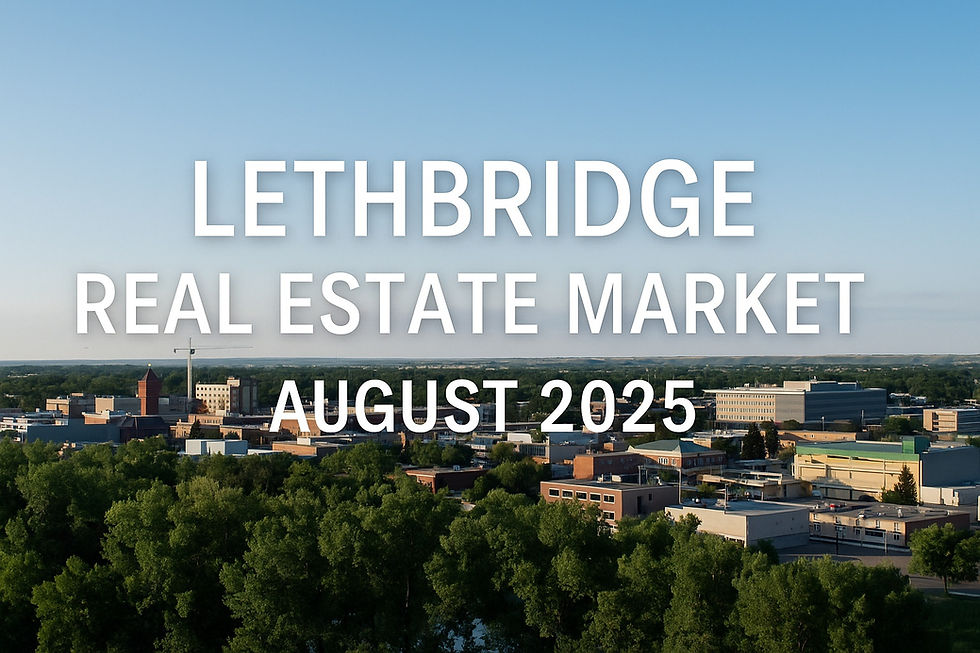Canadian Mortgage Rates August 2025: What Buyers, Sellers & Investors Need to Know
- Startritehomes.com

- 3 days ago
- 4 min read
Updated: 2 days ago
Mortgage costs set the pace for Canada’s housing market. After aggressive tightening in 2022–23, the Bank of Canada has held its policy rate at 2.75% through the summer, signaling a period of gradual normalization rather than a quick return to ultra-low borrowing costs.
Inflation has cooled—headline CPI fell to 1.7% in July—but core measures remain near the top of the Bank’s 1–3% band. Translation: rate relief is arriving, but slowly.

Canadian Mortgage Rates and Rules: August 2025 Update
August 2025 Snapshot:
5-yr fixed (insured): ~low 4s (best cases may dip just below)
5-yr fixed (conventional): ~mid 4s
5-yr variable (insured): ~around low 4s; varies by discount to prime
Key rule changes: 30-yr insured on new builds; $1.5M insured cap; easier straight-switch renewals; standard refi cap 80% LTV
Affordability Pressures Across Provinces
Affordability remains a top concern. RBC Economics reports that even with lower rates, households in Toronto, Vancouver, and Victoria face the toughest affordability conditions in decades. By contrast, Alberta, Saskatchewan, and Manitoba continue to offer more accessible entry points, making them magnets for interprovincial migration.
Why rates affect buyers, sellers, and investors differently
Buyers: qualification (stress test), monthly payment, and product choice (insured vs. uninsured) drive outcomes.
Sellers: demand depends on buyer qualification and sentiment.
Investors: cash flow hinges on borrowing cost vs. rent growth and vacancy.
Understanding these dynamics helps explain why mortgage rules have shifted to support broader affordability.
Current Canadian Mortgage Rates (August 2025)
Below are nationally advertised reference points; your quote depends on insurance status, credit, loan-to-value (LTV), property type, and lender promos.
Lowest advertised 5-yr fixed (insured): ~3.84% (national best).
Lowest advertised 5-yr fixed (insured), alternative source: ~3.89% (recent best).
Average 5-yr fixed (conventional): ~4.71%.
Some bank “specials” (example): posted promos near 4.6%–4.7% on 5-yr fixed.
Lowest advertised 5-yr variable (insured): ~3.90%.
Context: With the policy rate steady at 2.75%, many five-year fixed offers cluster around the low-to-mid 4s, while the absolute “floor” rates tend to be insured, prime-borrower products.
New Mortgage Rules Every Canadian Should Know
The past year has brought some of the most significant rule changes in over a decade:
30-year amortization (insured, first-time buyers, new construction)
Effective August 1, 2024, first-time buyers purchasing new builds can take 30-year insured mortgages (was 25), reducing monthly payments and easing qualification.
Insured price cap raised to $1.5M
Effective December 15, 2024, the insured purchase-price limit increased from $1.0M to $1.5M, expanding access to insured (often lower-rate) options in higher-priced markets.
Easier lender switching at renewal (stress-test relief)
Uninsured straight-switch renewals at federally regulated lenders were exempted from the stress test on Nov 21, 2024.
Low-ratio (insured) switches also received rule changes so borrowers can move lenders at renewal without re-qualifying (effective Dec 16, 2024).
Refinancing: standard cap and a notable exception
Standard practice: refinancing above 80% LTV isn’t permitted; borrowers with LTVs >80% require insurance and are not eligible for refinancing.
Exception (to add housing): a special insured refinance for secondary suites launched Jan 15, 2025, allowing up to 90% of post-renovation value (max as-improved value $2M; up to 30-yr amortization).
OSFI’s portfolio limits on highly-indebted borrowing
OSFI now applies institution-specific limits on the share of new uninsured mortgages with loan-to-income (LTI) > 4.5×. It’s a portfolio-level measure, not a per-borrower cap. If your LTI is near or above 4.5×, you may need to: increase your down payment, add income (e.g., co-borrower or rental), pay down debts, or consider an insured option (if eligible).
First Home Savings Account (FHSA) refresher
Eligible first-time buyers can contribute $8,000/year to an FHSA (tax-deductible; tax-free growth; withdrawals for a qualifying first home are tax-free).
Expert Insights on Rates and Affordability
What Leading Economists Are Saying
The Bank of Canada’s late-July decision to hold at 2.75% reflects progress on inflation but persistent core pressures. Markets now handicap gradual easing into late 2025 if disinflation persists.
Aggregators (WOWA/Ratehub) show insured five-year fixed rates at or just below 4%, while the national average conventional sits higher around 4.7%, underscoring how insurance status and LTV drive pricing.
Benjamin Tal (CIBC Capital Markets) notes that “mortgage demand is bouncing back faster than expected” thanks to lower insured rates.
Scotiabank Economics forecasts that the Bank of Canada’s policy rate will remain near 2.75% through 2025, only easing further in 2026.
How Banks and Lenders Are Responding
Big banks like RBC and BMO continue offering special rates, but many of the most competitive offers are coming through mortgage brokers. Online platforms like Nesto and WOWA highlight insured products under 4%, which remain in high demand.
What It Means for Buyers, Sellers & Investors
Strategies for homebuyers in 2025
If you’re a first-time buyer considering a new build, the 30-year insured option can materially lower payments—compare the 25- vs 30-year amortization to see total-interest trade-offs.
For those with <20% down, insured products often deliver the lowest rates; just budget for the insurance premium and confirm total cost of borrowing.
Opportunities and challenges for sellers
Modestly lower rates and easier switching at renewal expand the borrower pool and support demand, especially in mid-price segments.
Investor considerations under new rules
The 80% LTV refinance ceiling constrains leverage; however, the secondary-suite insured refi can unlock capital for adding units—evaluate rent potential, zoning, and all-in costs before proceeding.
Key Takeaway and Next Steps
Canadian mortgage rates have eased from 2024 peaks, with insured five-year fixed offers near the ~4% mark and conventional averages around ~4.7%. New rules—30-year insured amortization for first-time buyers of new builds, a $1.5M insured cap, and stress-test relief at renewal—shift the playbook for approvals, renewals, and refinancing. The bottom line: compare widely, label your scenario correctly (insured vs. uninsured, LTV, property type), and lock terms that fit your risk tolerance.
Why Comparing Rates Matters Now More Than Ever
With insured rates dropping below 4%, shopping around is critical. Two borrowers with identical profiles can still receive very different offers depending on lender and product type.
Ready for tailored advice or shopping homes for sale in Alberta? Navigating these shifts can be overwhelming, but you don’t have to do it alone. Use Pro Search to find top-rated real estate and mortgage experts in your area.
No referral fees, just direct access to vetted professionals who can help you make the right decisions.




Comments